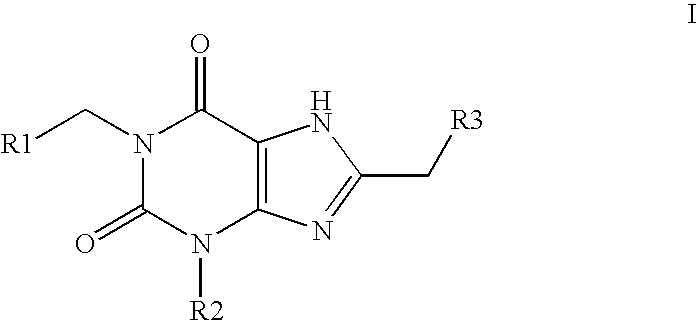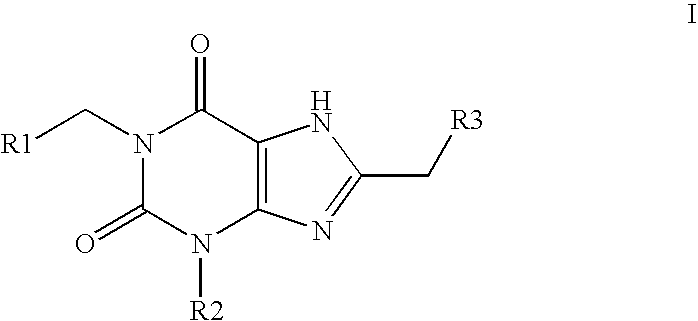Amide substituted xanthine derivatives
a technology of xanthine derivatives and amides, which is applied in the field of 1, 3, 8 substituted xanthine derivatives, can solve the problems of side effects, lactic acidosis, gastrointestinal disturbances, etc., and achieve superior efficacy, reduced side effects, and improved glucose homeostasis
- Summary
- Abstract
- Description
- Claims
- Application Information
AI Technical Summary
Benefits of technology
Problems solved by technology
Method used
Image
Examples
example 1
N-[4-(1-Allyl-3-butyl-2,6-dioxo-2,3,6,7-tetrahydro-1H-purin-8-ylmethyl)-phenyl]-acetamide
[0406]
[0407]This compound was prepared by the route outlined in scheme 1.
Step 1: Preparation of 6-Amino-1-butyl-1H-pyrimidine-2,4-dione.
[0408]
[0409]This compound was prepared by a method similar to method B as described by V. Papesch, E. F. Schroeder in J. Org. Chem. 1951, 16, 1879 except that the filtration step was replaced by concentration.[0410]In a 1 L flask was placed 330 mL of absolute ethanol and sodium metal (11.5 g, 0.5 mol) was added in small pieces. When all the sodium had reacted commercial N-butyl urea (34.9 g, 0.3 mol) and commercial ethyl cyanoacetate (33 mL, 35 g, 0.31 mol) were added. The resulting mixture was stirred at room temperature for ½ h and then heated at reflux for 25 h. After cooling to room temperature the resulting mixture was concentrated under vacuum to give an oily-solid residue. This residue was taken up in water, acidified by addition of a 6N aqueous hydrochlo...
example 2
N-[4-(1-Benzyl-3-butyl-2,6-dioxo-2,3,6,7-tetrahydro-1H-purin-8-ylmethyl)-phenyl]-acetamide
[0426]
[0427]This compound was prepared by a route similar to that used for the preparation of compound in example 1 and as outlined in scheme 1.
Step 1: Preparation of 6-amino-3-benzyl-1-butyl-1H-pyrimidine-2,4-dione.
[0428]
[0429]6-Amino-1-butyl-1H-pyrimidine-2,4-dione (1.72 g, 9.4 mmol), 1,1,1,3,3,3-hexamethyldisilazane (30 mL), and ammonium sulfate (0.03 g, 0.2 mmol) were heated under nitrogen at reflux for 24 h. After cooling to room temperature the 1,1,1,3,3,3-hexamethyldisilazane was removed under vacuum to give a light brown oil to which was added benzylbromide (1.1 mL, 1.58 g, 9.2 mmol) and a crystal of iodine. The resulting mixture was heated in a 110° C. oil bath for 1 h. The mixture was cooled in as ice bath while methanol was cautiously added. After concentration and trituration with chloroform and cooling to −20° C. freezer, the solid product was isolated by filtration. This material ...
example 3
N-[5-(1-Benzyl-3-butyl-2,6-dioxo-2,3,6,7-tetrahydro-1H-purin-8-ylmethyl)-pyridin-2-yl]-acetamide
[0437]
[0438]This compound was prepared by a method similar to that described in example 2 except that the hydrochloride salt of (6-acetylamino-pyridin-3-yl)-acetic acid was used in place of N-acetyl-4-aminophenylacetic acid in step 4 and the coupling was performed with O-benzotriazol-1-yl-N,N,N′,N′-tetramethyluronium hexafluorophosphate and diisopropylethyl amine in N,N-dimethylformamide. MS, m / z(M+)=446.2067.[0439][(6-Acetylamino-pyridin-3-yl)-acetic acid was prepared from 2-amino-5-bromo-pyridine (Aldrich) by the following 5 step procedure: (i) oxidation with 30% hydrogen peroxide in concentrated sulfuric acid according to the procedure of G.
[0440]J. Fox et al. as described in J. Chem. Soc. Perkin Trans I 1973, 68 to form 5-bromo-2-nitropyridine as a pale yellow solid (63%); (ii) malonate displacement of bromide was performed by the procedure of M. A. E. Bowman et al. as described in Or...
PUM
| Property | Measurement | Unit |
|---|---|---|
| Volume | aaaaa | aaaaa |
| Mass | aaaaa | aaaaa |
| Mass | aaaaa | aaaaa |
Abstract
Description
Claims
Application Information
 Login to View More
Login to View More - R&D
- Intellectual Property
- Life Sciences
- Materials
- Tech Scout
- Unparalleled Data Quality
- Higher Quality Content
- 60% Fewer Hallucinations
Browse by: Latest US Patents, China's latest patents, Technical Efficacy Thesaurus, Application Domain, Technology Topic, Popular Technical Reports.
© 2025 PatSnap. All rights reserved.Legal|Privacy policy|Modern Slavery Act Transparency Statement|Sitemap|About US| Contact US: help@patsnap.com



